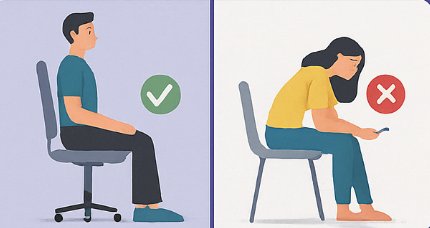Busting the Posture Myth: Why Sitting Up Straight Won't Save Your Back (But This Will)
The Surprising New Thinking on Back Pain and Posture
POSTURE
6/2/20253 min read


Busting the Posture Myth: Why Sitting Up Straight Won’t Save Your Back (But This Will)
The Surprising New Thinking on Back Pain and Posture
For generations, we’ve been told to “sit up straight!” or “stop slouching!” to avoid back pain. Good posture has long been hailed as the key to a healthy spine, while slumping or slouching was blamed for aches and injuries. But emerging research in physical therapy is turning that conventional wisdom on its head. Surprisingly, there is little evidence that upright posture prevents back pain—or that “bad” posture causes it. In fact, the real key may not be how you sit at all… but how often you move.
This fresh perspective – essentially “move more, worry less about sitting perfectly” – is shaking up the physical therapy world and offering new hope to anyone who’s ever struggled with neck or back pain.
New Research: Movement Matters More Than a Perfect Posture
Studies are increasingly debunking the old posture myth and revealing a more empowering truth. Research has found no consistent difference in sitting or standing posture between people with back pain and those without. In other words, some people with perfect posture suffer from pain, while others who slouch feel just fine.
One review even found that workers who followed strict ergonomic and lifting guidelines didn’t fare any better than those who didn’t. Even more surprising, people with chronic back pain were more likely to obsess over maintaining “perfect” posture—and yet still hurt.
So what actually helps? Movement.
In a recent 2024 study, adults who reduced their daily sitting time by just 40 minutes experienced less progression of back pain over six months. Researchers concluded that frequently changing positions and moving more throughout the day made a bigger difference than maintaining any “ideal” posture.
Gentle activity—like walking, stretching, or doing short bursts of movement—can have powerful effects. Rather than holding your spine in one static position, what your body really craves is variety.
Why This Topic Hits Home in Daily Life
Almost everyone can relate to worrying about their back or neck. Low back pain is the No. 1 cause of disability globally, affecting over 600 million people. From young adults glued to smartphones to seniors dealing with mobility issues, back pain is a shared experience—and a frustrating one.
This makes the topic deeply personal and incredibly relevant to everyday life.
Think about the average person working remotely at the kitchen table, slumped over a laptop. Or the office worker who just bought an expensive ergonomic chair, hoping it would finally fix their nagging neck pain. Or the parent who constantly reminds their kids to “sit up straight.”
The idea that bad posture isn’t the villain and that moving more is the real solution can feel shocking—but also incredibly liberating.
In fact, during the COVID-19 pandemic, the explosion in remote work led to a massive uptick in new or worsening neck and back issues. One study found that 25% of remote workers developed back pain after transitioning to home offices—often due to long hours in stiff chairs or awkward positions.
Yet despite the rise in ergonomic products and posture-correcting devices, pain rates haven’t dropped significantly. Why? Because the focus has been on position instead of movement.
This insight not only challenges common beliefs but offers a path forward that feels simpler, more natural, and more accessible. You don’t need a $500 chair or posture trainer—you just need to move more, more often.
Whether you're a student, a desk-bound employee, a retiree, or just someone who spends a lot of time on their phone, this shift in thinking is game-changing. You no longer need to fear the occasional slump or obsess over your spine. Instead, empower yourself with regular activity and variety throughout your day.
How to Apply This New Thinking Today
So if sitting up straight isn’t the solution, what is?
Here are a few movement-based strategies backed by physical therapists:
✅ 1. Shift Positions Frequently
There’s no single “perfect” way to sit. Instead, rotate between sitting upright, reclining slightly, or even perching on a stool throughout your day. Think of posture like food: variety is healthiest.
✅ 2. Set a Movement Timer
Every 30–60 minutes, stand up, stretch, walk around, or do a brief mobility exercise. These “movement snacks” refresh your body and prevent stiffness.
✅ 3. Incorporate Gentle Exercise
Walking, swimming, yoga, or light resistance work helps keep your spine strong and mobile. You don’t have to “work out” intensely—just move regularly.
✅ 4. Don’t Fear Bending or Lifting
It’s okay to bend and twist—your spine is designed for it! Practice lifting with awareness and good strength, but don’t be afraid to move naturally.
✅ 5. Listen to Your Body
If a position feels uncomfortable, change it. Your comfort is a better guide than arbitrary posture rules.
